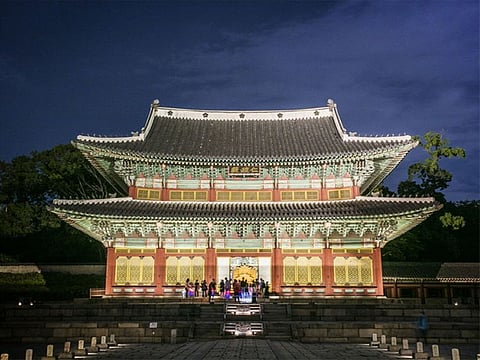Travelling to South Korea? Catch the foreign language guided tours at Changdeokgung Palace for the first time after COVID-19
The ‘Moonlight Tour’ for non-Korean speakers will be held for two nights only

After a three-year hiatus, foreign language-guided nighttime tours at South Korea’s Changdeokgung Palace will resume tomorrow, May 28.
Called the ‘Moonlight Tour’, the night-time tour allows visitors to enjoy an evening stroll around the royal palace holding a ‘cheongsachorong’, or a traditional lantern to light the way.
The guided tour is organised by the Cultural Heritage Administration’s Royal Palaces and Tombs Center and the Korea Cultural Heritage Foundation.
While the night-time tour was open to public in 2021 and 2022 as well, it is the first time since the COVID-19 pandemic that foreign visitors will be able to book guided tours in English, Chinese, and Japanese languages.
The foreign language guided tours for foreign tourists and non-Korean speakers will be available on two nights only – May 28 and June 4.
Changdeokgung was designated a Unesco (United Nations Educational, Scientific and Cultural Organisation) World Heritage Site in 1997. Though damaged, destroyed, rebuilt, and replaced throughout its history, it is known to be the most well-preserved palace of all the royal palaces from the Joseon Dynasty (1392 - 1910).
The palace is the second oldest in Seoul after Gyeongbokgung and was used as a secondary palace when first built. Located east of Gyeongbokgung Palace, it is regarded as a masterpiece of Korean palace architecture.
The Unesco website states that the palace was built following the principles of pungsu-jiri, Korea's version of Chinese feng shui. It is an ancient architectural principle, which involves the placing or arranging of buildings or other sites auspiciously, based on topography, to bring peace and prosperity.
According to the official website of the palace, it was built in 1405 by King Taejong, the third ruler of Joseon.
“All palaces in Seoul were burnt down during the Japanese invasion in 1592, and Changdeokgung Palace became the first palace to be rebuilt in 1610. Since then, it became the primary palace for about 270 years where 13 kings including the last monarch dealt with state affairs,” says the website.
The palace is also well-known among tourists for the Huwon Secret Garden. The 78-acre garden takes up about sixty per cent of the palace grounds and was used as a place of leisure by members of the royal family.
According to an April 6 article on the South Korean news website koreaherald.com: “[During the tour,] visitors will start at Donhwamun and walk through major buildings such as Injeongjeon, the main hall, and Huijeongdang, the reception hall. Visitors will be treated to the sounds of ‘daegeum,’ a traditional Korean woodwind instrument, and ‘ajaeng,’ a traditional string instrument, at the garden of Nakseonjae.
“Upon entering the Buyongji Pond area, visitors will come across a reenactment of the king and queen walking in the garden.
“A traditional Korean musical performance will also be staged at the Yeongyeongdang Hall, which was built by Crown Prince Hyomyeong as a banquet venue. A traditional dance called 'Bosangmu' has been newly added to this year’s program. The dance was created by the crown prince to celebrate the 40th birthday of his mother, Queen Sunwon, in 1828.”
The tour usually takes one and a half hours, and one ticket costs 30,000 won (Dh83.24).
Sign up for the Daily Briefing
Get the latest news and updates straight to your inbox



